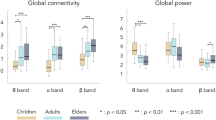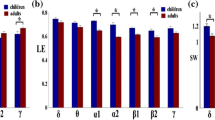Abstract—
Age-related trends in the strength of functional and effective connectivity between key cortical structures that belong to the three most important resting-state neural networks: the default mode network (DMN), the key event detection network (salience network, SN) and the central executive network (CEN) were investigated in adolescents of both sexes. The study involved 34 adolescents of the younger age group: 11–13 years old (12.61 ± 0.75 years, 13 girls and 21 boys) and 54 adolescents of the older group: 14–16 years old (15.00 ± 0.75 years, 20 girls and 34 boys). Frequency-specific estimates of the strength of functional and effective connectivity between the nodes of DMN, SN and CEN were computed in six frequency bands θ (4–7 Hz), α1 (7.5–9.5 Hz), α2 (10–13 Hz), β1 (14–18 Hz), β2 (20–27 Hz) and γ (30–40 Hz) using the vector autoregressive modeling of cortical sources of EEG registered in the resting condition. The analysis of functional connectivity revealed age differences in the θ frequency range, in which the strength of connections between the nodes of all networks in the younger age group was higher than in the older group. Besides, sex-related differences were found in the beta-2 and gamma ranges: the connections between the nodes of DMN were stronger for girls than for boys. The analysis of effective connectivity (directed influences) revealed a significant effect of age in all frequency ranges for the CEN and DMN resting-state networks; for SN, this effect was significant in all but the beta-2 and gamma ranges. The most pronounced age-related changes were found for bottom-up connections directed from more caudal to more frontal areas in CEN and DMN, and in the younger age group, the strength of effective connections was greater than in the older one. The effect of sex on the strength of effective connections was limited mainly to the younger group and manifested itself in stronger DMN and CEN connectivity in girls (as compared with boys) .


Similar content being viewed by others
REFERENCES
Fiziologia razvitia rebenka (Physiology of Child Development), Bezrukikh, M.M. and Farber, D.A., Eds., Moscow: Mosk. Psyhol.-Pedagog. Instit., 2010.
Cauffman, E., Steinberg, L., and Piquero, A.R., Psychological, neuropsychological and physiological correlates of serious antisocial behavior in adolescence: the role of self-control, Criminology, 2005, vol. 43, no. 1, p. 133.
Casey, B.J., Beyond simple models of self-control to circuit-based accounts of adolescent behavior, Annu. Rev. Psychol., 2015, vol. 66, p. 295.
Sorocco, K.H., Carnes, N.C., Cohoon, A.J., et al., Risk factors for alcoholism in the Oklahoma Family Health Patterns project: impact of early life adversity and family history on affect regulation and personality, Drug Alcohol Depend., 2015, vol. 150, p. 38.
Machinskaya, R.I., Brain executive systems, Zh. Vyssh. Nerv. Deiat. Im. I. P. Pavlova, 2015, vol. 65, no. 1, p. 33.
Lindquist, K.A., Wager, T.D., Kober, H., et al., The brain basis of emotion: a meta-analytic review, Behav. Brain Sci., 2012, vol. 35, no. 3, p. 121.
Salamone, J.D. and Correa, M., The mysterious motivational functions of mesolimbic dopamine, Neuron, 2012, vol. 76, no. 3, p. 470.
Salgado, S. and Kaplitt, M.G., The nucleus accumbens: a comprehensive review, Stereotact. Funct. Neurosurg., 2015, vol. 93, no. 2, p. 75.
Sharp, B.M., Basolateral amygdala and stress-induced hyperexcitability affect motivated behaviors and addiction, Transl. Psychiatry, 2017, vol. 7, no. 8, p. e1194.
Ishikawa, A., Ambroggi, F., Nicola, S.M., and Fields, H.L., Dorsomedial prefrontal cortex contribution to behavioral and nucleus accumbens neuronal responses to incentive cues, J. Neurosci., 2008, vol. 28, no. 19, p. 5088.
Rudebeck, P.H. and Murray, E.A., The orbitofrontal oracle: cortical mechanisms for the prediction and evaluation of specific behavioral outcomes, Neuron, 2014, vol. 84, no. 6, p. 1143.
Dixon, M.L., Thiruchselvam, R., Todd, R., and Christoff, K., Emotion and the prefrontal cortex: an integrative review, Psychol. Bull., 2017, vol. 143, no. 10, p. 1033.
Ahmed, S.P., Bittencourt-Hewitt, A., and Sebastian, C.L., Neurocognitive bases of emotion regulation development in adolescence, Dev. Cognit. Neurosci., 2015, vol. 15, p. 11.
Bressler, S.L. and Menon, V., Large-scale brain networks in cognition: emerging methods and principles, Trends Cognit. Sci., 2010, vol. 14, no. 6, p. 277.
Pessoa, L., Understanding emotion with brain networks, Curr. Opin. Behav. Sci., 2018, vol. 19, p. 19.
Bressler, S.L. and Tognoli, E., Operational principles of neurocognitive networks, Int. J. Psychophysiol., 2006, vol. 60, no. 2, p. 139.
Fox, M.D. and Raichle, M.E., Spontaneous fluctuations in brain activity observed with functional magnetic resonance imaging, Nat. Rev. Neurosci., 2007, vol. 8, no. 9, p. 700.
Kurgansky, A.V., Human brain functional organization in the resting-state, Zh. Vyssh. Nerv. Deiat. Im. I. P. Pavlova, 2018, vol. 68, no. 5, p. 567.
Damoiseaux, J.S., Rombouts, S.A.R.B., Barkhof, F., et al., Consistent resting-state networks across healthy subjects, Proc. Natl. Acad. Sci. U.S.A., 2006, vol. 103, no. 37, p. 13848.
Mohan, A., Roberto, A.J., Mohan, A., et al., The significance of the Default Mode Network (DMN) in neurological and neuropsychiatric disorders: a review, Yale J. Biol. Med., 2016, vol. 89, no. 1, p. 49.
Solé-Padullés, C., Castro-Fornieles, J., de la Serna, E., et al., Intrinsic connectivity networks from childhood to late adolescence: effects of age and sex, Dev. Cognit. Neurosci., 2016, vol. 17, no. 35.
Zhou, Y., Friston, K.J., Zeidman, P., et al., The hierarchical organization of the default, dorsal attention and salience networks in adolescents and young adults, Cereb. Cortex, 2018, vol. 28, no. 2, p. 726.
Uhlhaas, P.J. and Singer, W., Neuronal dynamics and neuropsychiatric disorders: toward a translational paradigm for dysfunctional large-scale networks, Neuron, 2012, vol. 75, no. 6, p. 963.
Srinivasan, R., Winter, W.R., and Nunez, P.L., Source analysis of EEG oscillations using high-resolution EEG and MEG, Prog. Brain. Res., 2006, vol. 1, no. 59, p. 29.
Grech, R., Cassar, T., Muscat, J., et al., Review on solving the inverse problem in EEG source analysis, J. Neuroeng. Rehabil., 2008, vol. 5, p. 25.
Darvas, F., Pantazis, D., Kucukaltun-Yildirim, E., and Leahy, R.M., Mapping human brain function with MEG and EEG: methods and validation, NeuroImage, 2004, vol. 23, suppl. 1, p. S289.
Baccala, L.A., Sameshima, K., Ballester, G., et al., Studying the interaction between brain structures via directed coherence and Granger causality, Appl. Signal. Process., 1998, vol. 5, p. 40.
Kurgansky, A.V., Study of cortico-cortical functional connectivity with vector autoregressive model of multichannel EEG, Zh. Vyssh. Nerv. Deiat. Im. I. P. Pavlova, 2010, vol. 60, no. 6, p. 740.
Kaminski, M. and Blinowska, K.J., The influence of volume conduction on DTF estimate and the problem of its mitigation, Front. Comput. Neurosci., 2017, vol. 11, p. 36.
Davey, C.G., Pujol, J., and Harrison, B.J., Mapping the self in the brain’s default mode network, NeuroImage, 2016, vol. 132, p. 390.
Assaf, M., Jagannathan, K., Calhoun, V.D., et al., Abnormal functional connectivity of default mode sub-networks in autism spectrum disorder patients, NeuroImage, 2010, vol. 53, no. 1, p. 247.
Dixon, M.L., De La Vega, A., Mills, C., et al., Heterogeneity within the frontoparietal control network and its relationship to the default and dorsal attention networks, Proc. Natl. Acad. Sci. U.S.A., 2018, vol. 115, no. 7, p. E1598.
Hallez, H., Vanrumste, B., Grech, R., et al., Review on solving the forward problem in EEG source analysis, J. Neuroeng. Rehabil., 2007, vol. 4, p. 46.
Litvak, V., Mattout, J., Kiebel, S., et al., EEG and MEG data analysis in SPM8, Comput. Intell. Neurosci., 2011, vol. 2011, art. ID 852961.
Pascual-Marqui, R.D., Lehmann, D., Koukkou, M., et al., Assessing interactions in the brain with exact low-resolution electromagnetic tomography, Philos. Trans. R. Soc., A, 2011, vol. 369, no. 1952, p. 3768.
Chen, A.C., Oathes, D.J., Chang, C., et al., Causal interactions between fronto-parietal central executive and default-mode networks in humans, Proc. Natl. Acad. Sci. U.S.A., 2013, vol. 110, no. 49, p. 19944.
Cui, J., Xu, L., Bressler, S.L., et al., BSMART: A Matlab/C toolbox for analysis of multichannel neural time series, Neural Networks, 2008, vol. 21, no. 8, p. 1094.
Di, X. and Biswal, B.B., Identifying the default mode network structure using dynamic causal modeling on resting-state functional magnetic resonance imaging, NeuroImage, 2014, vol. 86, p. 53.
Sharaev, M.G., Zavyalova, V.V., Ushakov, V.L., et al., Effective connectivity within the default mode network: dynamic causal modeling of resting-state fMRI data, Front. Hum. Neurosci., 2016, vol. 10, p. 14.
Sridharan, D., Levitin, D.J., and Menon, V., A critical role for the right fronto-insular cortex in switching between central-executive and default-mode networks, Proc. Natl. Acad. Sci. U.S.A., 2008, vol. 105, no. 34, p. 12569.
Friston, K., Causal modeling and brain connectivity in functional magnetic resonance imaging, PLoS Biol., 2009, vol. 7, no. 2, p. e33.
Lenroot, R.K. and Giedd, J.N., Brain development in children and adolescents: insights from anatomical magnetic resonance imaging, Neurosci. Biobehav. Rev., 2006, vol. 30, no. 6, p. 718.
Tsekhmistrenko, T.A., Vasilyeva, V.A., and Shumeiko, N.S., Structural rearrangements of the cerebral cortex in children and adolescents, Hum. Physiol., 2017, vol. 43, no. 2, p. 123.
Uddin, L.Q., Supekar, K.S., Ryali, S., and Menon, V., Dynamic reconfiguration of structural and functional connectivity across core neurocognitive brain networks with development, J. Neurosci., 2011, vol. 31, no. 50, p. 18578.
Sherman, L.E., Rudie, J.D., Pfeifer, J.H., et al., Development of the default mode and central executive networks across early adolescence: a longitudinal study, Dev. Cognit. Neurosci., 2014, vol. 10, p. 148.
Allen, E., Erhardt, E., Damaraju, E., et al., A baseline for the multivariate comparison of resting-state networks, Front. Syst. Neurosci., 2011, vol. 5, p. 2.
Zhang, C., Cahill, N.D., Arbabshirani, M.R., et al., Sex and age effects of functional connectivity in early adulthood, Brain Connectivity, 2016, vol. 6, no. 9, p. 700.
Thatcher, R.W., North, D.M., and Biver, C.J., Development of cortical connections as measured by EEG coherence and phase delays, Hum. Brain Mapp., 2008, vol. 29, no. 12, p. 1400.
Spear, L.P., Adolescent neurodevelopment, J. Adolesc. Health, 2013, vol. 52, suppl. 2, p. S7.
Squeglia, L.M., Jacobus, J., Sorg, S.F., et al., Early adolescent cortical thinning is related to better neuropsychological performance, J. Int. Neuropsychol. Soc., 2013, vol. 19, no. 9, p. 962.
Selemon, L.D., A role for synaptic plasticity in the adolescent development of executive function, Transl. Psychiatry, 2013, vol. 3, no. 3, p. e238.
Jung, M., Mody, M., Saito, D.N., et al., Sex differences in the default mode network with regard to autism spectrum traits: a resting-state fMRI study, PLoS One, 2015, vol. 10, no. 11, p. e0143126.
Barth, C., Villringer, A., and Sacher, J., Sex hormones affect neurotransmitters and shape the adult female brain during hormonal transition periods, Front. Neurosci., 2015, vol. 9, p. 37.
Sinclair, D., Purves-Tyson, T.D., Allen, K.M., and Weickert, C.S., Impacts of stress and sex hormones on dopamine neurotransmission in the adolescent brain, Psychopharmacology, 2014, vol. 231, no. 8, p. 1581.
Author information
Authors and Affiliations
Corresponding author
Ethics declarations
CONFLICT OF INTEREST
The authors declare the absence of any conflicts of interest, either actual or potential.
FUNDING
This work was supported by the Russian Foundation for Basic Research (Grant no. 17-06-00837-OGN).
ETHICAL STANDARDS
All studies were conducted in accordance with the principles of biomedical ethics, formulated in the Helsinki Declaration of 1964 and its subsequent updates, and approved by the local bioethical committee of the Institute of Developmental Physiology.
INFORMED CONSENT
Written informed consent was obtained from the parents of each participant for her/his participation in the study, signed after explaining the potential risks and benefits, as well as the nature of the upcoming study.
Rights and permissions
About this article
Cite this article
Machinskaya, R.I., Kurgansky, A.V. & Lomakin, D.I. Age-related Trends in Functional Organization of Cortical Parts of Regulatory Brain Systems in Adolescents: an Analysis of Resting-State Networks in the EEG Source Space. Hum Physiol 45, 461–473 (2019). https://doi.org/10.1134/S0362119719050098
Received:
Revised:
Accepted:
Published:
Issue Date:
DOI: https://doi.org/10.1134/S0362119719050098




